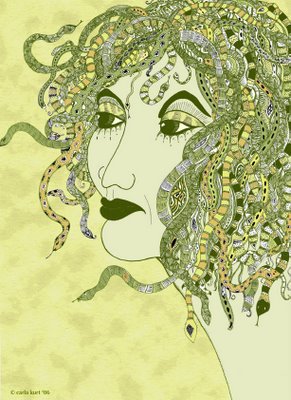
In poetry, the term
foot refers to the basic unit used in the scansion or measurement of metrical verse. A foot usually contains one accented syllable and one or two unaccented syllables. Certain poetic forms require not only a specific kind of meter, but also a set number of
feet per line. Shakespeare, for example, wrote his plays and sonnets in
iambic pentameter - five feet per line, with each foot comprised of one unstressed syllable followed by one stressed syllable.
The Muses of Greek mytholgy are goddesses who preside over the arts and sciences, invoked by poets and musicians for inspiration. Although there were originally many Muses, the Greeks favored nine: Calliope (epic or heroic poetry), Clio (historical and heroic poetry), Erato (love and erotic poetry), Euterpe (music and lyric poetry), Melpomene (tragedy), Polyhymnia (eloquence and dance), Terpsichore (dancing and the dramatic chorus), Thalia (comedy and pastoral poetry), and Urania (astronomy and astrology). Each Muse had a paticular object associated with her art. Erato, the muse of lyrical love and erotic poetry, is usually depicted with a lyre.
In his poem "On the Sonnet,"
John Keats writes about the poet's attempt to reconcile the demands of poetric structure with the pure inspiration of the Muses:
If by dull rhymes our English must be chain'd,
And, like Andromeda, the Sonnet sweet
Fetter'd, in spite of pained loveliness,
Let us find, if we must be constrain'd,
Sandals more interwoven and complete
To fit the naked foot of Poesy:
Let us inspect the Lyre, and weigh the stress
Of every chord, and see what may be gain'd
By ear industrious, and attention meet;
Misers of sound and syllable, no less
Than Midas of his coinage, let us be
Jealous of dead leaves in the bay wreath crown;
So, if we may not let the Muse be free,
She will be bound with garlands of her own.
(ink drawing/collage colored in photoshop)













